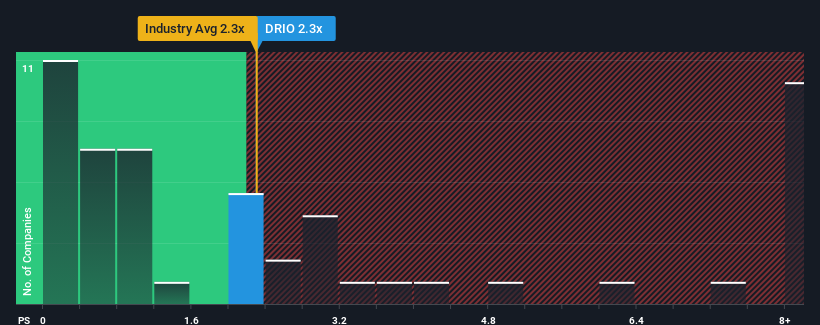
With a median price-to-sales (or "P/S") ratio of close to 2.3x in the Healthcare Services industry in the United States, you could be forgiven for feeling indifferent about DarioHealth Corp.'s (NASDAQ:DRIO) P/S ratio, which comes in at about the same. While this might not raise any eyebrows, if the P/S ratio is not justified investors could be missing out on a potential opportunity or ignoring looming disappointment.
Check out our latest analysis for DarioHealth

How Has DarioHealth Performed Recently?
While the industry has experienced revenue growth lately, DarioHealth's revenue has gone into reverse gear, which is not great. It might be that many expect the dour revenue performance to strengthen positively, which has kept the P/S from falling. However, if this isn't the case, investors might get caught out paying too much for the stock.
Want the full picture on analyst estimates for the company? Then our free report on DarioHealth will help you uncover what's on the horizon.What Are Revenue Growth Metrics Telling Us About The P/S?
The only time you'd be comfortable seeing a P/S like DarioHealth's is when the company's growth is tracking the industry closely.
Retrospectively, the last year delivered a frustrating 29% decrease to the company's top line. Still, the latest three year period has seen an excellent 100% overall rise in revenue, in spite of its unsatisfying short-term performance. So we can start by confirming that the company has generally done a very good job of growing revenue over that time, even though it had some hiccups along the way.
Looking ahead now, revenue is anticipated to climb by 61% each year during the coming three years according to the dual analysts following the company. That's shaping up to be materially higher than the 13% per year growth forecast for the broader industry.
With this in consideration, we find it intriguing that DarioHealth's P/S is closely matching its industry peers. It may be that most investors aren't convinced the company can achieve future growth expectations.
The Final Word
We'd say the price-to-sales ratio's power isn't primarily as a valuation instrument but rather to gauge current investor sentiment and future expectations.
Despite enticing revenue growth figures that outpace the industry, DarioHealth's P/S isn't quite what we'd expect. When we see a strong revenue outlook, with growth outpacing the industry, we can only assume potential uncertainty around these figures are what might be placing slight pressure on the P/S ratio. At least the risk of a price drop looks to be subdued, but investors seem to think future revenue could see some volatility.
You always need to take note of risks, for example - DarioHealth has 5 warning signs we think you should be aware of.
If you're unsure about the strength of DarioHealth's business, why not explore our interactive list of stocks with solid business fundamentals for some other companies you may have missed.
If you're looking to trade DarioHealth, open an account with the lowest-cost platform trusted by professionals, Interactive Brokers.
With clients in over 200 countries and territories, and access to 160 markets, IBKR lets you trade stocks, options, futures, forex, bonds and funds from a single integrated account.
Enjoy no hidden fees, no account minimums, and FX conversion rates as low as 0.03%, far better than what most brokers offer.
Sponsored ContentNew: Manage All Your Stock Portfolios in One Place
We've created the ultimate portfolio companion for stock investors, and it's free.
• Connect an unlimited number of Portfolios and see your total in one currency
• Be alerted to new Warning Signs or Risks via email or mobile
• Track the Fair Value of your stocks
Have feedback on this article? Concerned about the content? Get in touch with us directly. Alternatively, email editorial-team (at) simplywallst.com.
This article by Simply Wall St is general in nature. We provide commentary based on historical data and analyst forecasts only using an unbiased methodology and our articles are not intended to be financial advice. It does not constitute a recommendation to buy or sell any stock, and does not take account of your objectives, or your financial situation. We aim to bring you long-term focused analysis driven by fundamental data. Note that our analysis may not factor in the latest price-sensitive company announcements or qualitative material. Simply Wall St has no position in any stocks mentioned.
About NasdaqCM:DRIO
DarioHealth
Operates as a digital health company in the United States, Canada, the European Union, Australia, and New Zealand.
Excellent balance sheet slight.
Similar Companies
Market Insights
Community Narratives




